- News
- Reviews
- Bikes
- Accessories
- Accessories - misc
- Computer mounts
- Bags
- Bar ends
- Bike bags & cases
- Bottle cages
- Bottles
- Cameras
- Car racks
- Child seats
- Computers
- Glasses
- GPS units
- Helmets
- Lights - front
- Lights - rear
- Lights - sets
- Locks
- Mirrors
- Mudguards
- Racks
- Pumps & CO2 inflators
- Puncture kits
- Reflectives
- Smart watches
- Stands and racks
- Trailers
- Clothing
- Components
- Bar tape & grips
- Bottom brackets
- Brake & gear cables
- Brake & STI levers
- Brake pads & spares
- Brakes
- Cassettes & freewheels
- Chains
- Chainsets & chainrings
- Derailleurs - front
- Derailleurs - rear
- Forks
- Gear levers & shifters
- Groupsets
- Handlebars & extensions
- Headsets
- Hubs
- Inner tubes
- Pedals
- Quick releases & skewers
- Saddles
- Seatposts
- Stems
- Wheels
- Tyres
- Health, fitness and nutrition
- Tools and workshop
- Miscellaneous
- Buyers Guides
- Features
- Forum
- Recommends
- Podcast
review
£3,999.99
VERDICT:
Technology that works means comfort and performance though the twitchy steering takes the shine off a bit; change the tyres
Weight:
7,820g
Contact:
At road.cc every product is thoroughly tested for as long as it takes to get a proper insight into how well it works. Our reviewers are experienced cyclists that we trust to be objective. While we strive to ensure that opinions expressed are backed up by facts, reviews are by their nature an informed opinion, not a definitive verdict. We don't intentionally try to break anything (except locks) but we do try to look for weak points in any design. The overall score is not just an average of the other scores: it reflects both a product's function and value – with value determined by how a product compares with items of similar spec, quality, and price.
What the road.cc scores meanGood scores are more common than bad, because fortunately good products are more common than bad.
- Exceptional
- Excellent
- Very Good
- Good
- Quite good
- Average
- Not so good
- Poor
- Bad
- Appalling
The Pulsium 700 is Lapierre's answer to their pro riders wanting a comfortable race bike for cobbled classics and long hard days in the saddle. However, it's ended up with some interesting handling traits which might work on the farm tracks of Belgium but can feel a little nervous on smoother roads.

Ride
So what's the first thing you notice? Guaranteed it's the twin section top tube, reminiscent of GT's triple triangle design of the 90's. This one contains a rubber elastomer to iron out impacts from the hard edged cobbles. Well, if you are in the UK, hard edged potholes.

It works. It does actually smooth out the bumps on washboard surfaces and broken tarmac with very little in the way of spongy rebound when it's not wanted. The upper section of top tube works like a brace especially for the lateral forces from pedalling and cornering. A few times you put the hammer down and it feels a little soft but that's few and far between.
The chainstays are about 5mm longer than the majority of race bikes of this size to create a little more stability which in turn increases the length of the seatstays. These have been curved to act like leaf spring suspension, flexing on impact to reduce the vibration before it gets to your rear end. Most manufacturers curve away from the chainstays for comfort but Lapierre have gone the opposite way; it seems to work though. They've also gone for a 27.2mm seatpost as this will flex more than a similarly walled 31.6mm post.
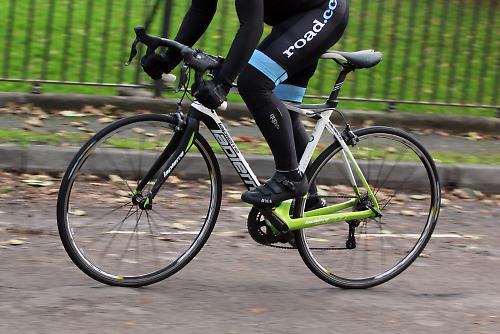
The other Lapierre Endurance frame the pros use is the Sensium which has a pretty standard 43mm fork offset. This has been increased to 50mm on the Pulsium to allow a curving of the fork to soak up vibration in the same way as the seatstays. The head tube angle has been reduced too, so the trail is almost the same, but it doesn't quite add up to the same handling.
At times the front end feels at odds with the rear of the bike, almost a bit like a 'cut and shut'. The rear end is subdued and follows the line nicely but you spend a lot of time putting small corrections into the steering.
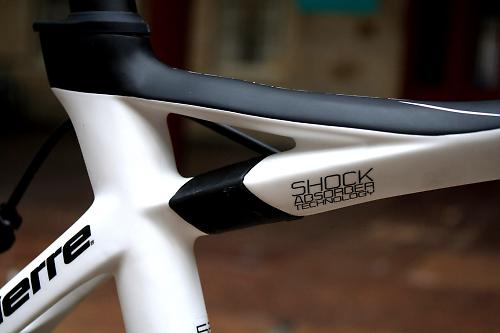
Finding some rough tracks to test it on finds things do get better. The quick steering helps you adjust your line as the bike slips and slides about beneath you. On the surfaced roads of the UK though it just becomes a bit tiring.
Handling aside the Pulsium is a very comfortable machine to ride for long days in the saddle. The whole of the top section of the frame, from the curved top tube to those seatstays are designed to flex and take the sting out of the ride and it works very well. You can get off of the Lapierre miles later and feel surprisingly fresh.
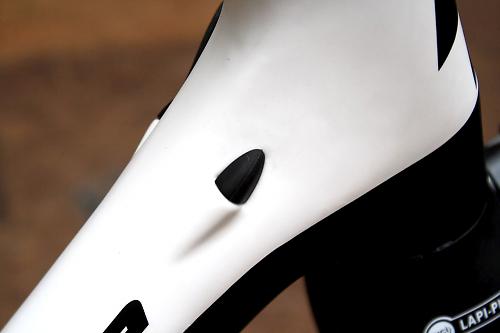
It's not what you'd call a sprinter's machine though. It doesn't feel as if it responds to hard efforts out of the saddle, instead preferring you to lay the power down from a seated position. From a rolling start it picks up speed quite effortlessly making you glad you've got Di2 to play with so that you can keep up with the gear changes.
Seated climbing feels a more effective use of your energy to rather than honking out of the saddle. That's fine on long steady drags but on short sharp climbs when you really want to give the bike a good wringing it feels kind of muted. You're still getting the speed but without the fun and feeling of payback.

When gravity starts becoming fun that twitchy handling comes into its own as high speed descending puts a massive grin on your face. Twists and turns are dealt with by a mere flick of body weight and you can put total confidence in the speed that it will take bends. In fact, it's so much fun that I was actively seeking out all the downhills I could find.
Rough surfaces mid bend don't unsettle the 700 and if you need to change your line you can, with the minimum of fuss.
Frame & Fork
To ensure the balance of comfort and power works the frame is designed in two parts, the head tube, down tube, bottom bracket and chainstays use what the designers call Power Box technology. Basically that means oversized to provide stiffness and power transfer.

Up front the head tube is tapered out to 1 1/4in at the fork crown and is 165mm tall on our medium test model giving an upright ride position. We aren't talking sit-up-and-beg town bike but it's noticeable you are taking a bit more wind. Not having all of your body weight on your wrists though is a welcome compromise for longer rides.
The top tube is designed curved to allow flex as it gets towards the seat tube but at the head tube end though it's noticeably fatter to maintain that stiffness provided by the headtube for steering and when you're pulling on the bars out of the saddle.

The elastomer ring is positioned near the seat tube to allow up to 3.5mm of flex at the junction there, 27% more than the Sensium that the pro team were using last year, Lapierre says. It works on the vibrations and bumps travelling up through the frame while the extra section of top tube is designed to keep things stiff in all other directions.
The bottom bracket uses Shimano's Press Fit bearing cups in the 86.5mm wide shell which gives more stiffness due to the extra width plus a larger surface area for bigger tube junctions. The down tube takes advantage of this by being larger too.

The chainstays have a pretty meaty profile too, being tall rather than fat to allow for plenty of heel and tyre clearance. The frame is actually designed to take 32mm tyres so you do need a fair bit of clearance. You'd need to swap to long drop brakes to achieve this, so Lapierre have included a smart little adjustable bracket on the brake bridge to allow for this.
The other half of the frame, seatstays, seat tube and fork, is all about comfort and I've mentioned how that works above. It's a good marriage of technology and the bike works as a whole rather than feeling like separate sections.

To get the desired ride feel and feedback Lapierre have used a three grades of carbon in various sections. For the stiffest areas they've used 40T with 30T and 24T modulus being used on the more flexible areas. It really highlights the level of R&D that goes into a professional spec frame with each material choice being used for a reason.
Finishing Kit
Whether you go for this Di2-equipped model or one of the mechanical ones all the cabling is internal leaving a very clean looking bike. The Di2 battery is in the seatpost, which looks much better than having a battery bolted somewhere on the frame and keeps it out of the elements. Not that we've ever had any issues with Di2 in the rain.

The 11-speed Ultegra Di2 is a full groupset. It's a lovely bit of kit to use with the light tap at the shifters making the bike very easy to ride especially over long distances. The only annoying thing is that when you start wearing thicker winter gloves the closeness of the buttons can lead to some missed shifts.
Whether you go for the mechanical or d12 version of Ultegra, the new dual pivot brakes are a highlight of the group, providing really great stopping power along with loads of feel and modulation at the lever.

The 700 is fitted with a 50/34T compact chainset and an 11-32T cassette which gives you plenty of gears whether you are climbing or descending, although there are quite a few large jumps in the ratios. To deal with the largest cog you get Shimano's medium cage rear mech which does look a little ungainly in my opinion but I'm guessing that'll be irrelevant when you're grinding up a 35% climb.
Once set up the Di2 worked faultlessly. It offers great value versus performance when compared to Dura-Ace. We've recently reviewed both the electronic and mechanical versions of Ultegra so check those out for the full low down on performance and specs.

Some Mavics these days come as a wheel and tyre system and that's what we've got here. The Equipes are the entry model in the Ksyrium range and have been constantly improved over the years. A claimed weight of 1690g without tyres is impressive and they do roll well, feeling light as you spin them up to speed.
The Yksion tyres on the other hand want putting in the bin if you are ever going to ride on a damp road surface. In the dry they grip fine and you can have a decent amount of confidence in them as you lean the bike over but as soon as a bit of moisture is about you might as well be riding on the alloy wheel rims. They are skittish and break away without warning which is unnerving to say the least on busy roundabouts.
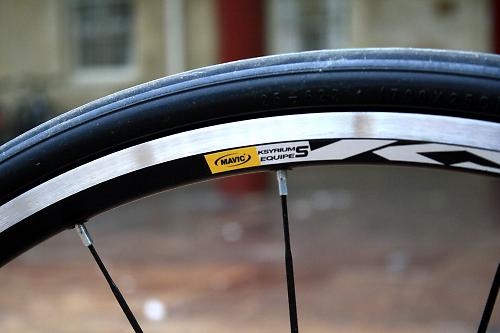
It's not often we see a bike coming with Zipp components as standard but they certainly worked really well with plenty of stiffness for the stem and bars and the latter are a comfortable shape too. The stem length and bar width you get is dependent on the size frame you go for.

Finishing things off is the Aliante saddle from Fizik which I find takes a little bit of breaking in and being set up to the millimetre before it starts to offer anything near a comfortable ride. Once you've got it dialled in though it's a good seat with firm padding and a supportive shape. As with all saddles though it's a personal choice.
Conclusion
A lot of design and engineering has gone into the Pulsium 700 and on the whole it's a successful project. The elastomer concept does provide a lot of comfort as you can feel it moving slightly to soak up the bumps in the road but most importantly with very little sacrifice in terms of stiffness and performance. Occasionally you'll get the odd rebound but they're few and far behind.
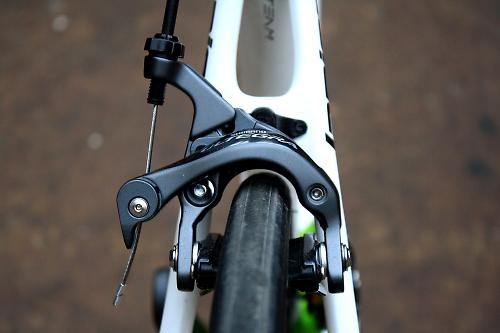
The twitchy handling on road is a bit on the irritating side though. It's not dangerous or difficult to ride or anything but compared to every other road bike I'm riding at the moment it's really noticeable how often you're making these tiny little steering corrections.
For long days in the saddle, though, the geometry and comfort provide a nice place to be for the duration of your ride. A sensible and durable build of alloy bars and the Di2 also add to the experience.
When you take everything into account, the R&D on the frame, the components and build quality the price is about right in my opinion. Change those tyres at the first available chance you get though.
Verdict
Technology that works means comfort and performance though the twitchy steering takes the shine off a bit; change the tyres.
road.cc test report
Make and model: Lapierre Pulsium 700
Size tested: 54
About the bike
State the frame and fork material and method of construction. List the components used to build up the bike.
Frame: PULSIUM CARBON, 40T,30T & 24T mix of modulus grades
Fork: LAPIERRE PULSIUM CARBON - Carbon Steerer & legs 50mm Offset
Headset: FSA 1"1/8 1"1/4 FSA ORBIT C-33 CF 44E 15 mm Carbon Top cover
Bottom Bracket: SHIMANO PRESSFIT
Crankset: SHIMANO ULTEGRA 50x34 170mm/172,5(M)/175(L,XL,XXL)
Stem: ZIPP Service Course 6° DIA:31.8 90mm(XS-S)/100(M)/110(L)/120(XL)/130(XXL)
Seatpost: LAPIERRE CARBON L:350mm DIA:27,2mm
Handlebar: ZIPP Service Course 80 anatomic W:40(XS)/42(S,M,L)/44(XL, XXL)
Front derailleur: SHIMANO ULTEGRA Di2
Rear derailleur: SHIMANO ULTEGRA Di2 11-SPEED
Shifters: SHIMANO ULTEGRA Di2 11-SPEED
Brakes: SHIMANO ULTEGRA
Saddle: FIZIK Aliante Delta Mg
Wheelset: MAVIC KSYRIUM EQUIPE WTS
Cassette: SHIMANO ULTEGRA 11-SPEED 11-32T
Tyres: MAVIC YKSION COMP 25
Tell us what the bike is for, and who it's aimed at. What do the manufacturers say about it? How does that compare to your own feelings about the bike?
The Pulsium was designed to be a pro level frame and wa ridden this year in the early season cobbled classics. Performance over rough surfaces was the brief, to provide the rider with as much comfort as possible without sacrificing speed. It is certainly comfortable and to its credit it feels more alive and fun to ride on rougher surfaces. That has come at a cost of a few sacrifices on smooth tarmac though.
Frame and fork
Overall rating for frame and fork
8/10
Tell us about the build quality and finish of the frame and fork?
It's a pro level frame and thats refected here in the quality of the construction. There is no buzzing or rattling coming from the carbon tubes at all and there are lots of smart little touches like the cable routing and brake adjustment to show that some thought has gone into the design. The matt paint finish is tough and well executed.
Tell us about the materials used in the frame and fork?
Everything is carbon fibre of which there have been three different grades used in various parts of the frame. 40T,30T or 24T modulus grades of carbon to define the amount of stiffness and comfort in each area.
Tell us about the geometry of the frame and fork?
It's a relaxed geometry as befitting of a bike in the Endurance range. A taller headtube (165mm on the medium) means a more upright position than a full on race bike.
The geometry chart can be found here - http://tinyurl.com/ncdg49d
How was the bike in terms of height and reach? How did it compare to other bikes of the same stated size?
The Pulsium has a long wheelbase of over a metre on this medium model with most of the extra coming from the increase in fork offset. This means that the stack and reach figures come in the same ball park of race bikes in the same size.
Riding the bike
Was the bike comfortable to ride? Tell us how you felt about the ride quality.
Yes, comfortable is the main point of the design and the carbon layup, geometry and the elastomer all work together to create a very pleasant ride.
Did the bike feel stiff in the right places? Did any part of the bike feel too stiff or too flexible?
Yes, considering the comfort it will still respond to hard efforts and an increase of speed.
How did the bike transfer power? Did it feel efficient?
The stiff bottom half of the frame delivers the power to the rear wheel even though it might not feel exactly exciting. The speed doesn't lie though.
Was there any toe-clip overlap with the front wheel? If so, was it a problem?
No.
How would you describe the steering? Was it lively, neutral or unresponsive? Lively definitely, an offshoot of changing the steering geometry has left the steering a little on the twitchy side.
Tell us some more about the handling. How did the bike feel overall? Did it do particular things well or badly?
On smooth roads it does require constant small steering tweaks which can become tiring especially if you are on roads busy with traffic. This doesn't become a problem once the speed increases like descending and as expected it becomes a benefit on rough tracks and roads.
Which components had the most effect (good or bad) on the bike's comfort? would you recommend any changes?
The components have very little to do with the comfort as the frame deals with the majority of it. Saying that though the Zipp bars have a small amount of flex in them which adds to comfort.
Which components had the most effect (good or bad) on the bike's stiffness? would you recommend any changes?
The Ultegra chainset is very good at putting down the power and once again those Zipp bars and stem worked well under cornering load.
Which components had the most effect (good or bad) on the bike's efficiency? would you recommend any changes?
The elastomer could occasionally absorb some of the effort you are putting into the pedals.
Rate the bike for efficiency of power transfer:
8/10
No feelings of flex in the frame where it wasn't supposed to be.
Rate the bike for acceleration:
8/10
Smooth and rapid from a rolling start
Rate the bike for sprinting:
7/10
Doesn't give much feedback and not what I'd class as a sprinters machine.
Rate the bike for high speed stability:
9/10
The lively handling comes intoplay here as does the frame over rough surfaces.
Rate the bike for cruising speed stability:
7/10
This is where the steering requires corrections, the 16-22mph range.
Rate the bike for low speed stability:
8/10
Negotiating urban areas is fine.
Rate the bike for flat cornering:
8/10
No dramas here.
Rate the bike for cornering on descents:
9/10
It comes into its own at high speed with quick line changes.
Rate the bike for climbing:
7/10
Finding a rythym seems best.
The drivetrain
Rate the drivetrain for performance:
9/10
Rate the drivetrain for durability:
8/10
Rate the drivetrain for weight:
8/10
Rate the drivetrain for value:
9/10
Tell us some more about the drivetrain. Anything you particularly did or didn't like? Any components which didn't work well together?
Ultegra is a lovely groupset and the Di2 offers really good value for money comparable to other electronic groupsets on the market.
Wheels and tyres
Rate the wheels and tyres for performance:
6/10
Rate the wheels and tyres for durability:
8/10
Rate the wheels and tyres for weight:
8/10
Rate the wheels and tyres for comfort:
8/10
Rate the wheels and tyres for value:
7/10
Tell us some more about the wheels and tyres.Did they work well in the conditions you encountered? Would you change the wheels or tyres? If so, what for?
The wheels are good all rounders in terms of performance and weight but the Mavic tyres aren't. Downright scary in the wet too.
Controls
Rate the controls for performance:
8/10
Rate the controls for durability:
8/10
Rate the controls for weight:
8/10
Rate the controls for comfort:
8/10
Rate the controls for value:
7/10
Tell us some more about the controls. Any particularly good or bad components? How would the controls work for larger or smaller riders?
Sensible kit choices have been made with a decent set of alloy bars and stem. The saddle is good to once you've dialled in the position.
Your summary
Did you enjoy riding the bike? On the whole yes but I'd have reservations about living with the handling.
Would you consider buying the bike? No.
Would you recommend the bike to a friend? Yes.
Rate the bike overall for performance:
7/10
Rate the bike overall for value:
8/10
Anything further to say about the bike in conclusion?
Overall the Pulsium is a good bike and it does what it's designed to do, offering comfort over long rides with poor surfaces while maintaining performance. Its almost too specific though as on smooth road surfaces that fast handling can become irritating. I like a bike to be engaging and responsive but this required just a little bit too much input. If it was your sole bike you'd get use to it but I had to keep readjusting every ride. If you want to cover big miles in comfort though and can live with the handling the Pulsium 700 could be worth a test ride.
About the tester
Age: 36 Height: 180cm Weight: 76kg
I usually ride: Kinesis T2 My best bike is: Kinesis Aithien
I've been riding for: 10-20 years I ride: Every day I would class myself as: Expert
I regularly do the following types of riding: time trialling, commuting, club rides, sportives, fixed/singlespeed,
Since writing his first bike review for road.cc back in early 2009 senior product reviewer Stu has tested more than a thousand pieces of kit, and hundreds of bikes.
With an HND in mechanical engineering and previous roles as a CNC programmer/machinist, draughtsman and development engineer (working in new product design) Stu understands what it takes to bring a product to market. A mix of that knowledge combined with his love of road and gravel cycling puts him in the ideal position to put the latest kit through its paces.
He first made the switch to road cycling in 1999, primarily for fitness, but it didn’t take long for his competitive side to take over which led to around ten years as a time triallist and some pretty decent results. These days though riding is more about escapism, keeping the weight off and just enjoying the fact that he gets to ride the latest technology as part of his day job.
Latest Comments
- BBB 2 hours 21 min ago
Inhumane system that now will be getting even worse.
- Bungle_52 5 hours 45 min ago
In case anyone missed it in yesterdays blog here are the two pevious articles. The second one contains the testimony from the driver....
- David9694 5 hours 54 min ago
The old role was appointed at the Mayor's pleasure; is in addition to the permanent staff of the Combined Authority. I'm not sure if Adam was an...
- WillPage 7 hours 20 min ago
Nothing says "welcoming environment" like uniformed thugs, umm I mean "security patrols " roaming the area.
- galibiervelo 8 hours 38 min ago
That is class news. Super bikes and vision. Bet there will be no stand at the Taiwan bike show next year! Big luck to all the team
- Destroyer666 9 hours 20 min ago
Pretty clearly stated several times in the text that the issue was not related just to his son. And besides, everybody watching the races could see...
- Rendel Harris 9 hours 36 min ago
All Fizik and Selle Italia saddles (though not all their other products) are made in Italy I believe, and their 3D printed models definitely are.
- chrisonabike 10 hours 1 min ago
If you're not on the road with a car, I bet its driver is much less likely to swerve into your space *. Because you're not "in the way"! (Any...
- mdavidford 10 hours 18 min ago
The problem with this argument, though, is that it's just not true....































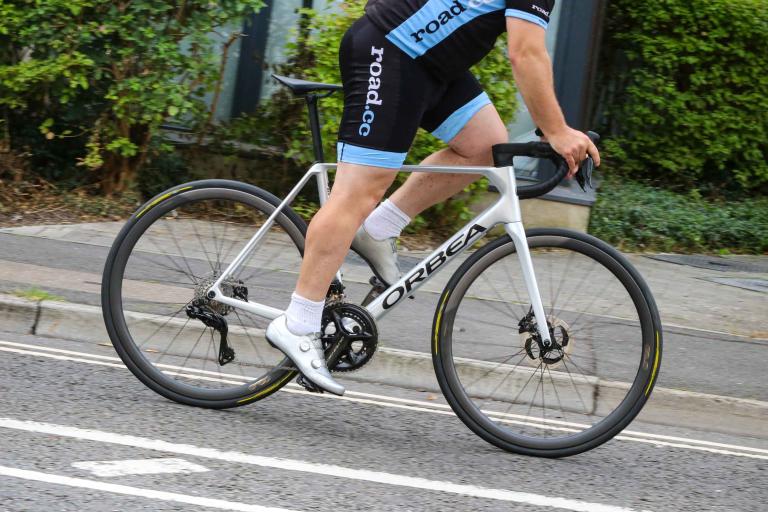
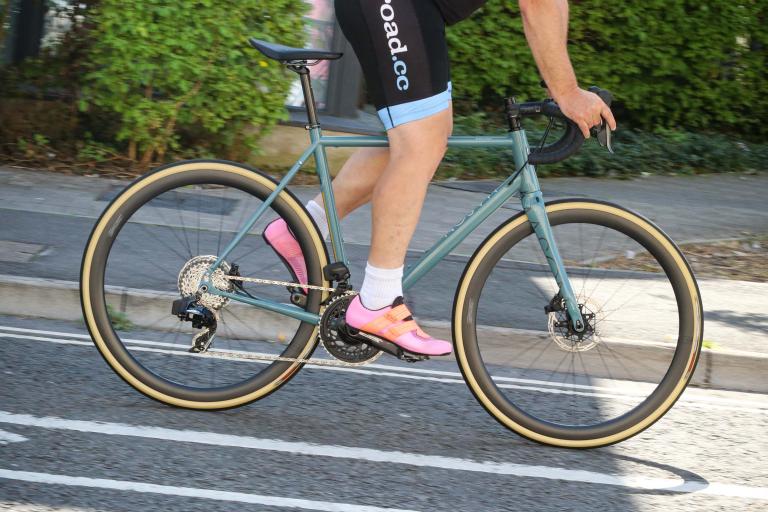
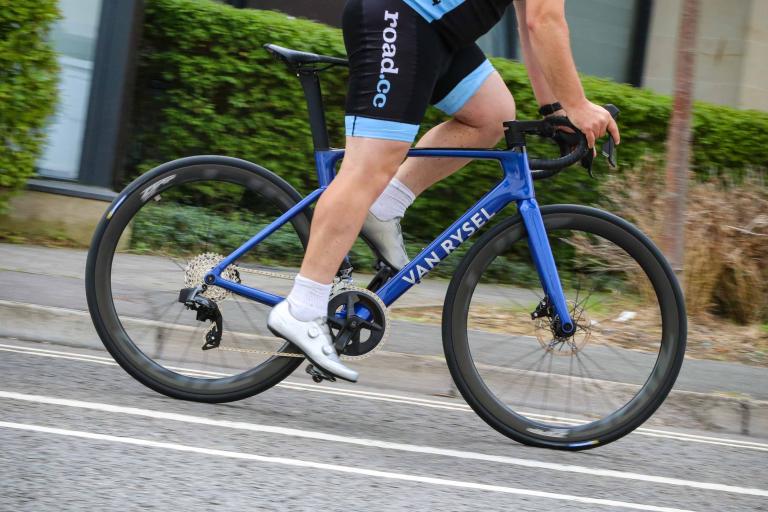
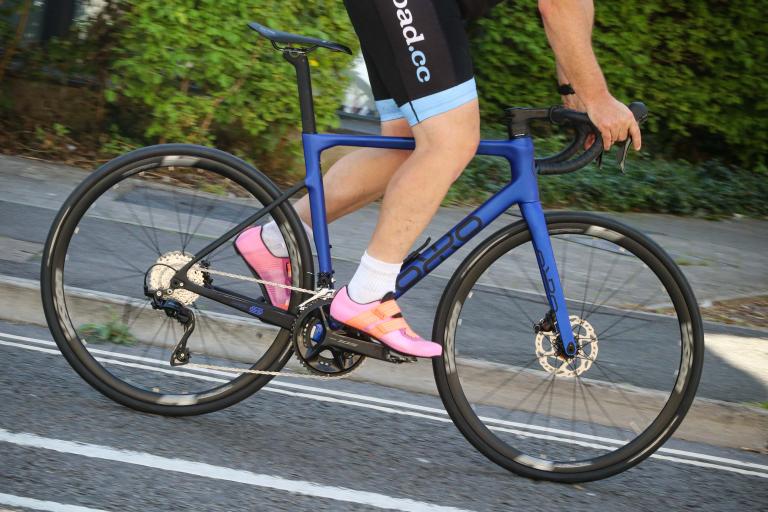
Add new comment
11 comments
I bet that the belly makes more difference to the ride characteristics than the elastomere, from experience of the belly.
It's interesting how the "front end feels at odds with the rear of the bike, almost a bit like a 'cut and shut'" but "the bike works as a whole rather than feeling like separate sections."
It is interesting for sure Nick. It has to be down to the longer stays and overall longer WB, versus the very short Trail. The HA angle seems to be in a typical range at 72, so presumably no issue there.
The first comment is in regards to the handling whereas the second is in relation to the upper and lower sections of the frame being designed for a comfort / performance balance. #context
You talked about twitchy handling, but you didn't provide the exact Trail numbers. With a 50mm fork Rake, the Trail is probably shorter than most race bikes. I'd be interested to see the number.
Given the long-ish rake, it makes sense that the front end would feel a bit twitchy.
Shock absorption is similar to dampening, and both are dissimilar to 'suspension' (at least in the way you were describing pivots and degrees of freedom like some trail bike).
I don't so much doubt that it works at all really so much as how much it works. The only way to compare is to ride the damned thing against the alternatives. But I'm not likely to be doing that, are you?
If the elastomer is providing suspension then there must be some measurable deflection in the frame so how much is it?
This is a bad joke to say this frame has suspension. The frame is rigid throughout and the there is no pivot point or degrees of freedom for the elastomer section to work as suspension. The frame may have a little give from a kinked top tube and longer chainstays, but the elastomer section is just a marketing gimmick.
I think you're taking that too literally. What he said was:
Which is seen on quite a few bikes. The elastomer works more as a dampener (if it works at all).
I think you're taking that too literally. What he said was:
Which is seen on quite a few bikes. The elastomer works more as a dampener (if it works at all).[/quote]
Your words "if it works at all" translates to you doubting any possible benefits as well. The LaPierre website even states the PULSIUM 700 is "equipped with of the most significant innovations of this year: all-new SAT (Shock Absorption Technology)." Truly a bad joke and a stretch of the imagination.
Where is all the money going on this Cannondale, sorry Lapierre? 4 grand for ultegra di2, a hefty weight and very budget wheels?
I'm struggling....